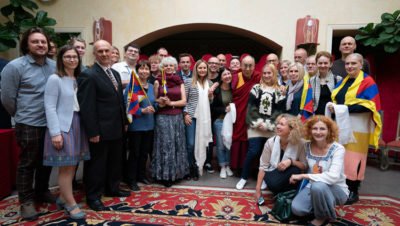
His Holiness the Dalai Lama joining members of the Lithuanian Parliamentary Group for Tibet and Tibet supporters for a group photo in Vilnius, Lithuania on June 14, 2018. Photo by Tenzin Choejor
June 14, 2018. Vilnius, Lithuania – Meeting with members of the Lithuanian Parliamentary Group for Tibet and Tibet supporters this morning His Holiness the Dalai Lama told them:
“We’ve been passing through a difficult period with extensive human rights violations in Tibet, but my main concern is for the preservation of Tibet’s unique cultural heritage. This is rooted in the ancient Indian understanding of the workings of the mind, on the basis of which we can achieve peace of mind and tackle our destructive emotions. This is something that is very much relevant today.
“We appreciate the support of friends like you. The people in Tibet’s spirit remains strong and when you show concern it not only gives them courage, it also sends a clear message to Chinese hardliners that the Tibetan issue has to be dealt with in a realistic way. Therefore, I would like to thank you on behalf of the six million Tibetans.”
Answering a question about different kinds of maps, His Holiness remarked:
“Political boundaries are the creation of bureaucrats, which may or may not reflect cultural boundaries. Historically the Chinese empire was characterized by political power, the Mongolian empire by its military prowess and the Tibetan empire by its spiritual strength. There was a brief period when Mongolia dominated both Tibet and China by military means. On the other hand, Tibet’s preoccupation with spiritual affairs meant that its influence extended to what is now, Kyrgyzstan, Afghanistan and Iran in the west, to much of China in the east, to Mongolia in the north and the Himalayan Region and the border with Burma in the south. Therefore, a map reflecting the extent of Tibetan Buddhist culture would be much larger than a political map of Tibet.”
While posing for photographs with people holding Tibetan flags, His Holiness told them a story.
“When I was in Beijing in 1954-55 I met Chairman Mao several times. We developed a close relationship—he was very kind to me, almost like a father to his son. On one occasion he asked if we Tibetans had a national flag. Somewhat hesitantly I answered, “Yes”. He approved and told me we should fly it alongside the Red Flag. So if anyone criticizes you for displaying this flag, you can tell them the Dalai Lama was given permission to do so by Chairman Mao himself. “
Meeting with Prof Vytautas Landsbergis, who became President of Lithuania when it achieved independence following the collapse of the Soviet Union in 1991, His Holiness recalled, “How happy I was when you invited me here in 1991. I was so moved and impressed by the people’s joy, enthusiasm and determination. It was an honour to be here among you.”
At the Siemens Arena His Holiness was introduced to the crowd of more than 2500 by the Mayor of Vilnius, Remigijus Šimašius. As he presented the Mayor with a traditional white scarf, His Holiness explained what it meant.
“The colour white represents warm-heartedness, truthfulness and honesty. The smooth texture of the scarf represents non-violent conduct—trying to help others whenever you can and refraining from harming them. At the end here, written in Tibetan, it says ‘May whoever is given this be happy night and day’. This kind of gift was first offered in India and has been adopted in Tibet. Since the silk the scarf is made of originated in China, the gift reflects a sense of harmony between India, Tibet and China.”
Addressing the crowd as brothers and sisters, His Holiness continued, “If we really thought of the rest of humanity as our brothers and sisters there’d be no room for bullying and cheating each other. Thinking of ourselves as somehow special only leads to loneliness, because the reality is that every human being’s future depends on other human beings. Of course it’s natural to want to look after your own interests, but you have to do so in a wise rather than a foolish way. That means taking others into account and considering their concerns as well as your own. If the people around you are happy, obviously you’ll be happy too.” When a member of the audience asked how to reconcile traditional and modern teaching methods His Holiness suggested that to start with it’s important for parents to show their children maximum affection. In schools it is a teacher’s responsibility to take an affectionate interest in their students well-being as well as providing them with instruction. For example, she or he might explain how anger disrupts our peace of mind, while compassion sets the mind at ease and fosters good health.
“My first teacher of compassion was my mother. As part of my Buddhist training I read a great deal about the qualities of altruism, but she was the first person to demonstrate it in practice.”
At the end of his talk His Holiness thanked the audience for their interest and for staying awake. He urged them to think about what he had said.
“No matter what work you do, if we each make the effort, we can create a more peaceful world. I also believe that smaller nations like the Baltic States are sometimes freer to be creative and take a lead in this process in international affairs.”
Tomorrow, His Holiness will travel to Riga, Latvia, where he is to teach Tsongkhapa’s ‘In Praise of Dependent Origination’ and the ‘Diamond Cutter Sutra’, as well as giving Manjushri permission.
https://www.dalailama.com/news/2018/meeting-with-tibet-supporters-and-public-talk-in-vilnius